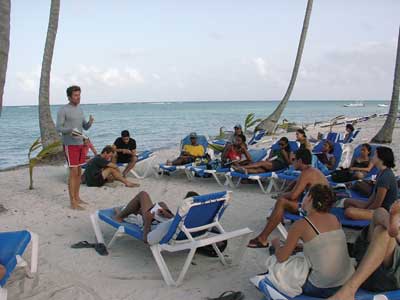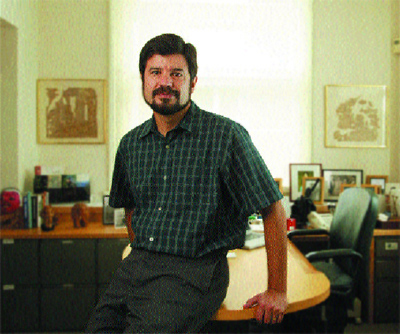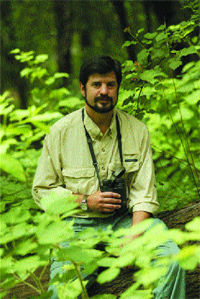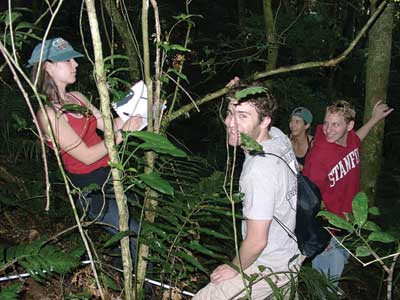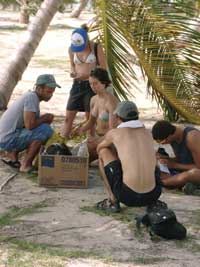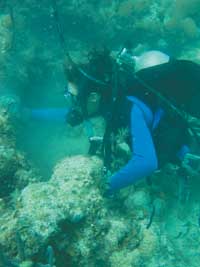|
|
 |
 |
 |
 |
|
FEATUREConservation, Preservation, EducationDon Melnick and CERC are leading the way to a sound environmental future.By Adrian Macdonald '99 Don Melnick wants every student who graduates from Columbia College to leave with a clear understanding of the basic environmental processes that society relies on for its survival. He wants students to be articulate and knowledgeable about the hard environmental choices they will face in their lifetimes. He thinks New York City is not an unusual place but an ideal place to learn about society's relationship to the natural world. And he thinks environmental literacy is as crucial to civilization as literacy in politics, history and the arts. "These are the things that I consider someone must know to be an educated person," he says. "They're critical parts of the human endeavor."
Melnick is distinguished professor of evolutionary and conservation genetics in the Department of Ecology, Evolution and Environmental Biology (E3B), established in 2001, and executive director of the Center for Environmental Research and Conservation (CERC), a consortium of five New York-based science and research institutions founded in 1995 to address the challenges of conserving the Earth's biological diversity in the face of rapid global change. He also is co-coordinator of the United Nations Millennium Task Force on Environmental Sustainability. Melnick is not interested in producing an army of activists - rather, the next generation of aware citizens. "We're not an advocacy organization, we're not the Sierra Club," he says. "Not that there's anything wrong with that. That's just not what we are." As he and his colleagues put it, "We are educating the environmental leaders of tomorrow." Melnick wants students to appreciate environmental issues from all sides, in all their complexity, uncertainty, and, above all, profound relevance to society. He believes students need a chance to leave the classroom and learn about the environment in the environment itself, in the rainforests of the tropics and on the streets of Harlem. And he wants them to see it from a scientific perspective. This fall, the first class of the new Science Core kicked off with an IMAX film at the Lincoln Square cinema, selected by Melnick, called Lost Worlds. The film features a sequence on New York City where the audience is taken for a ride up the faucet of a sink in a Manhattan apartment and through the city's underground water system, finally ending up in the Catskill Mountains, in the network of forests that make up the New York watershed. Clean water in New York, it turns out, is not provided by a water filtration system. Microorganisms in the soil around the reservoir do the job much better, for free.
Drinkable water, Melnick explains, is an example of what ecologists in the trade call "ecosystem services" - free services provided by nature with economic value to society. Another example is pollination of fruit trees by bees. "No one goes around and brushes on pollen," he says. "That would be incredibly expensive and time-consuming. People don't value these things because they don't pay for them." The list of services that biological diversity provides goes on and on, encompassing everything from bats that control pests on corn crops to the balance of ecosystems that keeps in check emerging infectious diseases, such as Lyme disease. In certain areas of the world, rural landscapes that are subject to extreme environmental degradation lead to rapid immigration into cities and greater violent crime. So even if you hate nature and couldn't care less about the beauty of the natural world, argues Melnick, you should still be concerned about biodiversity. His mission is to make students understand that biodiversity is central to everything that society needs to function - water, human health, food, climate, even civil order. During the fall semester, Melnick is leading three classes of the collaboratively taught Science Core course, covering evolution, genetics and biological diversity, and he offers a semester-long biodiversity course for non-science majors. Many describe the impact of Melnick’s thinking on the College, and the University, as immense. “Don Melnick is an environmental visionary,” says Steven Cohen, vice dean of SIPA and director of educational programs at Columbia’s Earth Institute. Having spent the last 22 years — virtually his entire professional career — at Columbia, Melnick is well poised to make the changes he envisions. Growing up in and around New York, he studied history and anthropology at NYU and received his Ph.D. in physical anthropology from Yale in 1981. Melnick’s work has centered on evolutionary processes in primates, an interest that developed during an anthropology course at NYU. “I broke my leg playing basketball,” he recalls. “So I only wanted to take courses on the first floors of buildings.” One of those was “Introduction to Anthropology,” and when Melnick learned how much traveling was involved in the field, he was hooked. Later, he conducted major research on primates in ecosystems around the globe and became a pioneer in conservation genetics. People close to Melnick often express admiration for his single-minded focus on doing exactly what he sets out to do and his ability to achieve markedly ambitious goals. His first administrative achievement was to bring organismal biology — the study of life on the scale of whole organisms and ecosystems — back to Columbia. From the 1920s to the 1950s, Columbia was considered the world center for evolutionary, organismal biology. In the second half of the century, however, biological research began to shift to the cellular and molecular level, and in 1966, the zoology and botany departments merged to create the department of biological sciences. Macroscopic biology at Columbia, as at many universities, faded away, and research in the field continued primarily at institutions such as museums, zoos and botanical gardens. In recent years, however, interest in the environment has surged, and with it comes a refreshed demand for university courses such as ecology, evolution, zoology, botany and population genetics. Melnick, a physical anthropologist and chair of Columbia’s anthropology department from 1989–93, saw a niche, and in 1993, he made one of the boldest moves of his career: He called together a group of senior scientists from five of New York City’s greatest scientific institutions — Columbia University, the American Museum of Natural History, the Wildlife Conservation Society (which runs the Bronx zoo, Central Park zoo and New York Aquarium), the New York Botanical Garden and the Wildlife Trust — to consider a major new endeavor.
At the time, Melnick and his family — wife Mary Pearl, president of the Wildlife Trust; daughter, Memy ’04 and son, Seth — were a faculty family in residence at Schapiro Hall. “All of the first meetings were in our apartment,” Melnick recalls. “We immediately struck a chord.” The next year, the five institutions agreed to form CERC, which would collaborate on environmental education, training and research. The fledgling group received generous funding from the V. Kann Rasmussen Foundation and later from the MacArthur Foundation, and as a result, Columbia gained an adjunct faculty base in large-scale biological sciences of nearly 100 — the largest and most diverse group of faculty of its kind in the world. “We’re Columbia University in the City of New York,” says Melnick. “If we don’t take advantage of the knowledge of all these scientists living in New York, what are we doing?” CERC is one of a dozen research and teaching centers that comprise the Earth Institute at Columbia under the direction of Jeffrey D. Sachs, who came to Columbia in July 2002 after more than 20 years at Harvard. “I was thrilled when I learned that I would be directing an organization that collaborates so closely with the American Museum of Natural History, the Wildlife Conservation Society, the New York Botanical Garden and the Wildlife Trust,” said Sachs. “It will take an organization of CERC’s stature and amazing scientific research to help policymakers around the world to manage our natural resources in a sustainable and equitable manner.” This opportunity to bring together a broad coalition, with Columbia at its core, made CERC attractive to its early backers. “One of the V. Kann Rasmussen Foundation’s earliest grants (in 1991) was $1,275,000 to the Columbia College Rabi Scholars Program,” explains foundation trustee Martin V. Kaplan ’61, past president of the College Alumni Association. “That positive experience encouraged us to make what turned out to be our largest grant, $12 million over 10 years, for the creation of CERC. The trustees were impressed with Don Melnick, who brought us the concept of a center that would knit together major institutions in New York that had drifted apart during the prior half-century. Collaboration among grantees is a key goal of many of the foundation’s grants, and it was clear that all of the institutions had bought into the collaborative relationship around shared goals.” The creation of the E3B department was a key step in the growth of the program, because at Columbia only departments can hire faculty. Melnick and his colleagues put an interdisciplinary degree program in place, offering a B.A. in environmental biology, an M.A. in conservation biology and a Ph.D. in ecology and evolution. Then Melnick began lobbying the faculty of Arts & Sciences to create a new department, E3B. The proposition was a brave one, as the last time Columbia had created a department from scratch was in the 1940s. But in 2001, following a two-year process that culminated with a vote by the Board of Trustees, E3B was born. True to form, Melnick was not interested in creating an ordinary science program. "We've always tried to be incredibly creative, we've always tried to think of what's not going on," he says. "One of the things that was not happening was enough true experiential learning in science." To design the undergraduate major in environmental biology, now housed in the E3B department, Melnick drew on the vast resources assembled within CERC. The result was a unique internship program that has, since the major's inception in 1997, drawn increasing numbers of students. In the summer between their junior and senior years, all majors are required to take a field or lab research internship - normally as part of a project conducted by one of CERC's hundreds of scientists and affiliates - and then write a senior thesis on their work. These frequently involve traveling to exotic locations around the world. "It was amazing," reports Emily Seidman '04, who spent last summer studying the interactions of coral, algae and sea urchins in a remote lagoon in Belize. With project leader Tim McClanahan of the Wildlife Conservation Society, Seidman examined the recent rapid decline of the coral reef and its possible causes, snorkeling daily to check research markers. Seidman feels that her experience was like a science project and a semester abroad rolled into one. The crew members who ran the research station were locals who loved to talk about their country. "A lot of the people there make their living as fishermen, but they're also very proud of the environment."
Funding for the undergraduate internships comes from private sources. Joseph H. Ellis '64, who had been involved with environmental conservation organizations for many years, became interested in CERC early on and was a generous contributor to the internship program as it was getting started. Melnick prides himself on being able to find a leading researcher among the CERC institutions for any aspect of conservation science. "It's like one-stop shopping," he says. Kate Gluzberg '04 spent the summer in Hawaii with a researcher from the U.S. Fish and Wildlife Service, connected to CERC through the Wildlife Trust. She analyzed the possible routes by which the West Nile Virus might enter Hawaii. "Hawaii is one of the few states that has yet to come in contact with the virus," Gluzberg says, adding that birds are particularly susceptible to the virus and that "about a third of the birds on the endangered species list are endemic to Hawaii." Her research on quarantine procedures led her to recommend a policy of more stringent protocols in airports and shipping centers, but she met with resistance from state authorities. There were too many unanswered questions, they said, and they gave her "other factors to consider that we hadn't. But that's the way science works - there are always more questions to consider." Not all students leave the city for their research. Tim Bean '04 worked at the Wildlife Conservation Society's Geographical Information Systems lab in the Bronx to create an ecological map of pre-colonization Manhattan. "It was fun," he says. "It was nice to be able to look at Manhattan in a different way." Using maps made by the British army during its occupation of the island in 1782 and extrapolating from current knowledge about the area, Bean and project leader Eric Sanderson pieced together details of the topography, soils, vegetation and fauna present in 1609, the year Henry Hudson first sailed through the harbor. The goal, says Bean, is to connect people's awareness of biodiversity to where they live and work. The project's plans are to extend to all five boroughs and to map a timeline of changes from 1609 to the present. For Sanderson, CERC has provided an excellent opportunity for collaboration with re-searchers around the city as well as being a great source for interns. "Columbia students are going to have a lot of influence on the world," he says. "It's important for them to realize what's happening to the world and what they can do to change it." Melnick's innovations in environmental education have not stopped with majors. His objective being to engage as many students as possible in thinking about biological diversity, he had to face the fact that at least 8 in 10 undergraduates at the College do not think of themselves as scientists and have no intention of pursuing careers in science. "We realized there was a whole group of people at Columbia who were not necessarily interested in science, people who will go into law or business, who will become writers, politicians, doctors," he says. The best way to reach those people, Melnick decided, was to create a science class that no one could resist. Think of the most interesting course in environmental biology you can. It could involve spending a summer on tropical beaches in the Caribbean or hiking through the rainforests of Brazil. You might learn from the locals how to identify plants and animals, talk to them about the environmental issues where they live, maybe design your own research project. There would even be pleasant accommodations in a bed-and-breakfast style posada and excursions on the weekends to soak up the local culture. If that sounds too good to be true, it's not. That course, called Summer Ecosystem Experiences for Undergraduates (SEE-U), has completed its third year. And it's not your typical field trip. "These students learn a lot about ecology," says Melnick. James Danoff-Burg, the E3B professor who designed the course and currently directs the program (after Melnick initially conceived of the idea and acquired the University's approval), calls it "the single most rewarding teaching experience of my life." In five weeks, SEE-U students fulfill their entire two-semester science requirement in an intensive immersion in ecology at field stations in either the Dominican Republic or Brazil. Classes run from 9 a.m. to 5 p.m. and normally are made up of guided field experiments in the wilderness with the instructor, TAs and local experts assisting the process as students try to answer a scientific question posed to them at the beginning of each day. The evenings and weekends are spent on individually designed research projects - true scientific research, where students develop an original hypothesis, acquire and analyze data and present their results to the class. Most of the students have no science background or affinity. "I don't hate science anymore," says Stephanie Mendez '05, who completed the course in Brazil this summer. Mendez, who plans to study human rights and political science, liked the experience so much that she stayed an extra three weeks to explore the area. She says that she no longer views environmental conservation as a luxury for the wealthy. "I believed that before I went there, just because of the way we're exposed to it here in the States," she admits. But the biologists at the Instituto de Pesquisas Ecológicas, SEE-U's host institution near São Paulo, impressed her with its ability to incorporate the needs of local people into its solutions to ecological problems. "In some cases, it's tripled [the locals'] income," she says. "It's a win-win situation."
Talibah Newman '06, a film and African-American studies major, did research in the Dominican Republic on the noni plant, a small evergreen tree known throughout Asia and the Pacific for its medicinal qualities. "I'm a kinesthetic learner," she says. After a few weeks of training in the course, she was able to design a project measuring the health and abundance of the plant in relation to what ecologists call "edge effects," in this case, hiking trails. Accounting for variables such as soil type, water availability, herbivory and plant size, Newman determined a relationship between the plant's distance from the trail and its relative success in the ecosystem. "Students do genuine primary research for that ecosystem," says Danoff-Burg, who dreamed of taking such a course in high school. "The class is not canned." Much of the research, in fact, ends up used by local conservationists, and every year some of the projects "are completely novel - things that I hadn't thought of, and I thought, 'Wow, that's a beautiful way to answer that question.' The challenge for me . is to try to keep up with this industrious, intelligent group of inquiring minds." Melnick feels strongly about the importance of experiences such as SEE-U. "What some people call 'experiential learning,' " he says, "is going to some cooked-up lab where they already know the result of the experiment. Well, no scientist knows what the result of his or her experiments will be. That's not how science is done." Many of the scientists from the CERC institutions who teach courses at Columbia agree and they look to create courses that are as rewarding for the scientists as for the students. Michael Balick, v.p. for research and training and director of the Institute of Economic Botany at the New York Botanical Garden, as well as a CERC founder and a member of its board of directors, finds it important for students to "break out of the 'safe' lecture/exam mold of education and face the challenges of interacting with people outside the university and learning to do research." Balick and his NYBG associate, Charles Peters, are professors for a combined graduate and undergraduate E3B course on ethnobotany, the study of the relationship between plants and people. The main course requirement is for students to devise a botanical research project to conduct in the city's urban environment. One project was a study of whether plant diversity in hotel lobbies is related to room rate, while others have investigated plant uses in Chinese and Hispanic areas, such as in alternative medicine practices. One student ran a transect down 125th Street and inventoried all the tuber crops for sale in the bodegas, finding more than 80 species. Balick found the student's presentation particularly moving: "He said the most gratifying thing was that in four years as an undergraduate, this was the first time he'd gotten out of the dorms and off campus and interacted with local people of different origins than him. It was a great awakening for him." Balick and Peters have plans to publish a book of the best student projects from the class. Eleanor Sterling, director of the Center for Biodiversity and Conservation at the American Museum of Natural History, co-teaches an E3B course on conservation biology that uses Central Park as a prime example of ecological restoration. "Biodiversity is not out there in this other place," she explains. "Restoration is not just in the Appalachians but in the middle of New York City." But restoring Central Park also raises many philosophical questions, which she poses to students: To what state should the park be restored? Manhattan has changed over time even without human influence, and, before European colonization, the Native Americans were here, burning and modifying the environment. Tens of thousands of years ago, Manhattan was a glacier, and hundreds of thousands of years ago, it was the top of a mountain. What then, Sterling asks, is the meaning of a "pristine environment"? Part of the course requirement is for students to design restoration projects in the park, answering some of these questions. As CERC completes its 10th year this spring, Melnick sees the consortium's activities only growing. "The initial challenges of getting everyone engaged have already occurred," he says. "Now, [the challenge] is not to be inhibited about what we can achieve." CERC supports several programs apart from its complementary relationship with E3B, including a new summer training program for K-12 science teachers that uses the Hudson River as a laboratory. For working professionals in other fields, CERC has offered since 1997 a well-received evening certificate program in conservation biology through the Morningside Institute. Fred Koontz, executive v.p. of the Wildlife Trust and a wildlife biologist whose recent work focuses on the New York City region, is one of 20 scientists from CERC institutions who teach courses for the certificate. "The work of professional biologists will fail unless the public will to save biodiversity is behind it," he says. "The first step is getting armed with knowledge."
Melnick appears to have boundless energy to lead these and more programs through whatever lies ahead. While juggling multiple responsibilities as executive director at CERC, professor in the E3B department, head of a busy research lab in conservation genetics, leader of a UN task force on environmental sustainability and parent, he amazes one and all with his optimism and persistence. "That's exactly the kind of attitude we need in conservation today," says Koontz. "It's easy to get discouraged. He just keeps correcting course and moving forward." Major collaborative research initiatives among members of the five institutions are just beginning and show Melnick's trademark ambition. One will attempt a full-scale analysis of New York City from an environmental perspective, detailing the dynamic systems that make the city work. Another aims to bring CERC's collaborative, organizational spirit to universities and institutions around the world to create a massive observational network, exhaustively documenting as many ecosystems in as many regions as possible. "If I were to tell you right now that we do not have a good comprehensive picture of life on Earth, you would be stunned, right?" Melnick says. "There's a lot of exploration that needs to be done." That includes regions from the jungles of Indonesia to the Catskill Mountains. "There's no one place that's really been comprehensively described. And that's crazy, because we have the technology and tools to do it. What we lack is the money and manpower." CERC will host the 2004 Society for Conservation Biology meeting at Columbia next summer, and it maintains a schedule of public lectures and seminars. Melnick expects that the activity of professionals centered on campus may spark increased interest for undergraduates. Environmental biology is the third largest science major in the College, after biology and psychology, and one of the fastest growing majors College-wide, despite its heavy course load. Melnick has a message for all College students: "Everything in life involves tradeoffs," he says. "And when you're dealing with environmental issues, it's not black and white. We're not going to set aside the world for every other species other than humans, because humans control the world." But as such, he points out, humans have the ultimate responsibility for sustaining and managing that world - not just for the sake of other species but also for their survival. Melnick adds, "They're going to look at the environment in a different way, and maybe they'll do whatever they're going to do in a different way." As the environmental leaders of tomorrow, students represent Melnick's greatest hope for the future. Adrian MacDonald '99 is a freelance environmental journalist. He lives in New York City.
|
|
||||||||||||||||||||||||||||||||||||||||||||||||||||||||||||||||||||||||||||||
